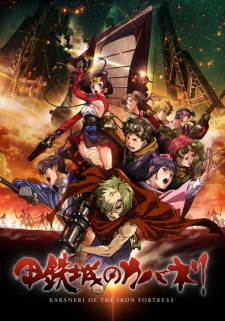
At the intersection of zombie infestation, steampunk aesthetic, and samurai culture lies Kabaneri of the Iron Fortress, the latest post-apocalyptic world directed by Araki Tetsurou, who seems to have found himself a fairly successful niche in the halls of eternal anime fame after Attack on Titan, Guilty Crown, and Highschool of the Dead all hit the jackpot. Even if he had decided to take Kabaneri down the same path as its spiritual predecessor Attack on Titan, producing a knockoff world where the pervasive grip of rampant death is slowly dumped in favor of a B-list human antagonist with his finger on the pulse of both human and zombie civilization, at the very least the atmosphere of mixing feudal Japan with Industrial Revolution England, set against a distinctly Western style of fast-and-vicious zombie, provides a lasting image that would cement its place in our minds. Or so I thought, but when the B-list antagonist shows up the show quite literally goes off the rails, and by the end I had to rewatch the powerful early episodes to remind myself of why I gave it a shot to start.
Perhaps it was emulating its predecessors too strongly, which certainly gave rise to a worthwhile opening. Right off the bat we see all the major players in our show through a palate of orange and black, from the feudal city and steam train to the samurai and engineers to the monsters they fight, the monstrous Kabane with glowing hearts exposed on their chests safe behind a cage of solid steel. We learn quickly that one bite is enough for infection, the countermeasure of choice being a small explosive bag the people put to their hearts and end it all before they fully transform. We meet Ikoma, an abrasive headstrong boy who desires nothing more than to kill the Kabane, who took his family from him in the past (read: Eren Yeager with a monocle). He is continuously testing out a pressurized rifle with enough power to break the Kabane’s heart cage, finally getting his chance at the end of the first episode but also being bitten in the process. In a decisive moment he survives by nearly strangling himself to death, gaining the body of a Kabane while keeping the mind of a human. And so a Kabaneri is born.
From there, the rest of his city is overrun by the Kabane, and while many are killed or beaten back by a nameless samurai girl with a ribbon on her neck and superhuman strength, eventually she, Ikoma, and the rest of the surviving samurai and engineers jump on board a train, the Koutetsujou, and they break out from the city. The rest of the show is set to be centered around their voyage on the train, looking for food and surviving outposts. Ikoma is decisive and headstrong, accomplishing much of what the regular crew can’t, and the nameless girl trains him to be a proper Kabaneri, but for their status as a potentially destructive Other both are confined to the outskirts of the train society, constantly eyed by the top samurai warriors who are looking for an excuse to kill them both. A few well-animated fight sequences later, as well as some public human moments from the two of them, and they are slowly allowed to move back into the sunshine, even gaining respect from the other warriors on the train. And so the show proceeds in a straightforward but entertaining fashion, albeit overburdened with names for the various Kabane, cities, and trains that weren’t necessary to keep the strong visual and musical aspects from keeping this ship afloat.
And then, we meet Biba. Biba is tall with flowing pink hair, kind and a born leader on the outside but with hidden secrets fueling a desire for revenge. He lives on a philosophy that the strong survive and the weak die as the natural fundamental rule in the world, and with it he slowly poisons the nameless girl’s mind, harnesses the power of the Kabane, and takes over the Koutetsujou and its crew for the sake of attacking the center of the surviving Japanese civilization, where the cruel shogun rules from on high. In other words, Biba is the textbook model for a JRPG villain, both in build and character alike, and the show doesn’t put a shred of thought into developing him any further. No redeeming or unique qualities, nothing but philosophical speeches and ruthless murder.
He takes hold of the nameless girl and sets her as the ultimate enemy of the Koutetsujou, and of her beloved Ikoma, because apparently they got emotionally close in the three seconds we see them talking about happiness and a world without Kabane. Ikoma finally gets a sense of purpose other than killing mooks, and sets out to put a pressurized bullet into his heart. All the supporting characters either drop off the face of the earth or are fodder for Biba’s takeover, with a handful serving as the quiet resistance to his plans. We lose all notion of atmosphere and tension, and are forced to watch this god-awful jig that he set up. And where can it all end? The nameless girl has to be brought back from her lost state, Ikoma has to confront Biba himself, and somehow they found the need to throw a whole other superpower mechanic into the mix before promptly pulling all the aftereffects at the eleventh hour. Kabaneri of the Iron Fortress builds an aesthetic that works, an atmosphere of desperation and survival on par with the best post-apocalyptic worlds, and blends visual styles and motifs in a unique way. And most importantly, it teaches us why all that and more can be useless in the face of poor writing and relying on tropes, especially ones by a shitty JRPG villain.